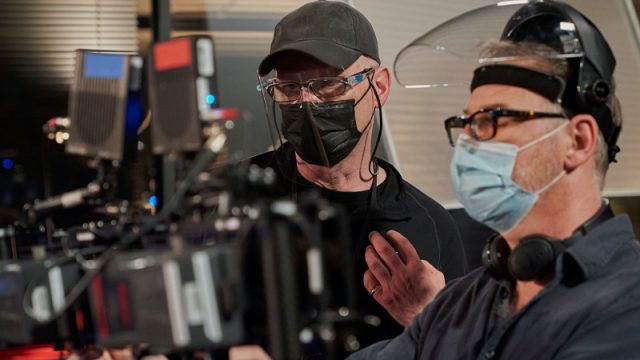Thom Best is an acclaimed cinematographer best known for Showtime’s groundbreaking series Queer as Folk, the Emmy winning TV movie Run The Wild Fields, Lifetime’s Emmy nominated and GLADD Award-winning Prayers for Bobby starring Sigourney Weaver, and the cult horror film Ginger Snaps for which he received a Genie nomination. Best’s career spans the gamut of genres from horror to comedy, westerns to science fiction, working in feature films, television series, and TV movies.
ComingSoon’s Jeff Ames spoke to Best about his career as a cinematographer and his most recent work on National Geographic’s limited series The Hot Zone: Anthrax, which is now available to stream on Hulu..
Jeff Ames: What led you to become a Director of Photography?
Thom Best: I grew up around cameras since both my parents were portrait photographers and we lived above their studio. I discovered my father’s Super8 camera when I was about 10 and began shooting small things with my friends. Star Wars made a huge impact on me and I knew then that I wanted to work in movies. In high school I made two films, one a short film called Star Grad for the graduating class ahead of me and one feature-length that I received school credit for.
After graduating, I saved up and bought a 16mm camera and began shooting news segments for local TV stations while also attending film workshops. My first actual paid gig was shooting archive footage of Queen Elizabeth’s opening of the Aviation Museum in Winnipeg. I soon realized that a career in film and television would require film school and I attended SAIT – Southern Alberta Institute of Technology where I met several filmmakers who I would continue to work with throughout my career, one of which was John Fawcett who directed the episodes (202 and 203) of The Hot Zone: Anthrax that I shot.
What was it about The Hot Zone: Anthrax that made you want to work on it?
One factor was a chance to work with John Fawcett again. I shot his first two features, The Boys Club and Ginger Snaps and we’ve worked together on several TV series through the years like Queer as Folk, The Bridge, and most recently Nurses. John and I have a shorthand and we understand how each other works. Another reason I wanted to work on this show was that it is a recreation of a period that we lived through, but an event that wasn’t well known or understood.
What was the most challenging aspect of Hot Zone: Anthrax and how did you overcome that?
The most challenging part of this show was the recreation of actual events that so many people witnessed through their own experience or through the news footage of the day, like the Pentagon crash, the news conference at 30 Rock, and the post office reports seen in our episodes. For the Pentagon sequence, we needed a stretch of highway with a field of green grass beside it but it was late spring in Toronto when we were shooting and we had lots of snow. Highways were a difficult find, so we ended up shooting in a parking lot which gave us the control we needed and a separate park location provided the grass that we shot later in the schedule.
As for 30 Rock, being an iconic location made it a difficult find. We ended up in the lobby of an office tower downtown that had the black marble walls and the art department added the distinctive flooring. VFX was left to add the artwork on walls above if required. And the post office was a unique challenge because it required a large working space with conveyors, sorting facilities, loading docks, and offices. And because we were shooting during COVID, no working post office would allow us to shoot in its facility. We found a massive clothing manufacturer’s warehouse that was workable but just before we were preparing to shoot, they pulled the plug. We ended up shooting in a gigantic retailers’ supply warehouse that was very challenging to light but worked beautifully in the end.
Do you have any fun, behind-the-scenes stories about the making of The Hot Zone: Anthrax?
Nothing springs to mind other than I thoroughly enjoyed my time on The Hot Zone: Anthrax. I was lucky to work with an amazing crew of incredibly talented people from my superstar gaffer Chris Harmsworth and Steadicam/A Cam Operator Angelo Colavechia to the wonderful producer David Rosemont and showrunners/writers Brian Peterson and Kelly Souders. And it was great to collaborate with another DP, Steve Lawes, an opportunity I haven’t had before.
What were some of the things you learned from Hot Zone: Anthrax that you’re excited to apply to future endeavors?
The biggest takeaway for me from this show was my experience working with the Sony Venice camera for the first time. It was the show’s pilot DP, Steve Lawes’ desire to use it based on his recent experience, and I agreed to test it. I too was very impressed with it, especially with its dual ISO feature which has changed the way I work, allowing me to light more naturally. It’s liberating knowing that you can shoot in nearly any situation when a location isn’t always ideal. I was so impressed that I took it to my next show and will continue to use it on future productions. I can’t wait for the release of the latest version, the Venice 2.
Do you have any other projects coming up that you can share with us?
My next project is Amazon Studios’ Kids in the Hall reboot. It will stream in 2022 and you won’t want to miss it. Stay tuned!










